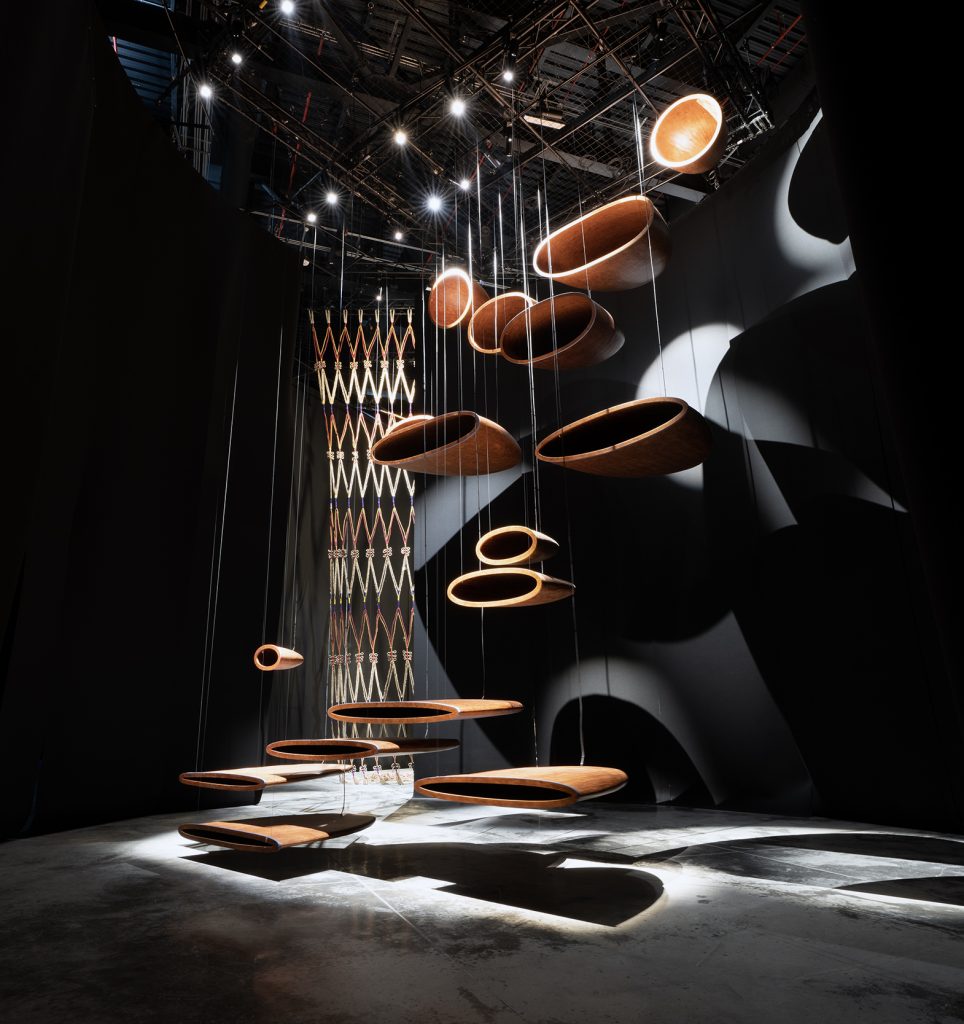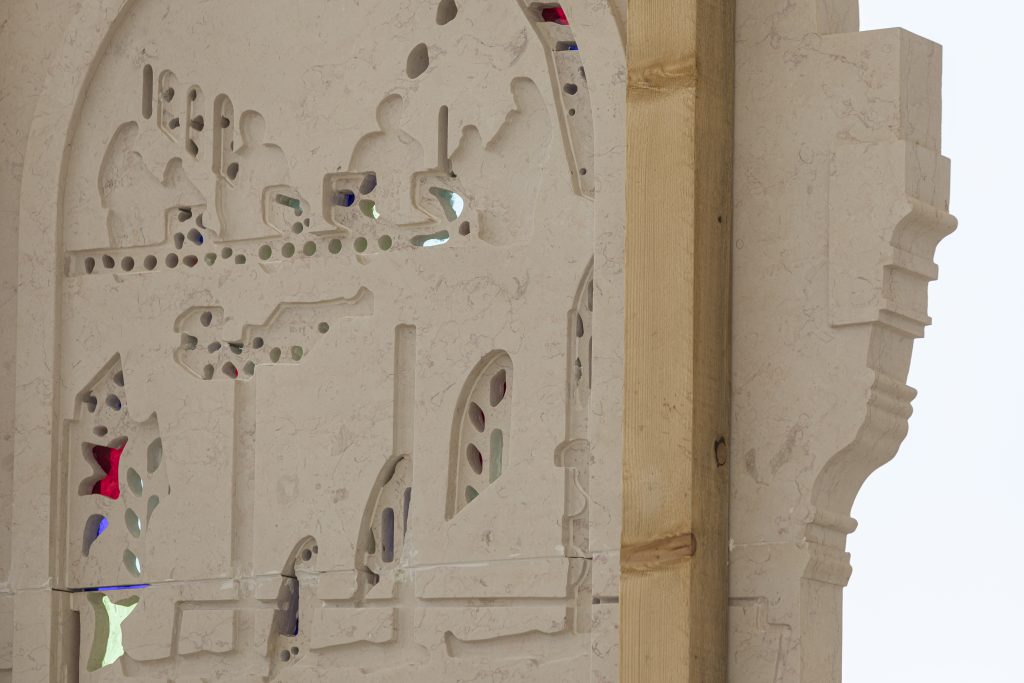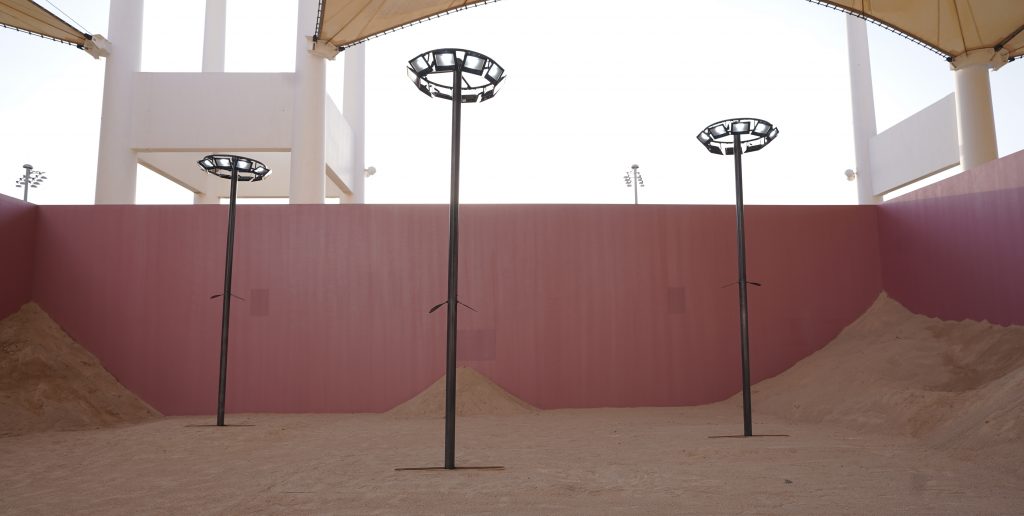In a male-dominated industry, London-based Sumayya Vally has become one of the most exciting, innovative and freshest voices in architecture.
Vally is Founder and Principal of architectural firm Counterspace, which focuses on expressions for African and Islamic hybrid identities, rooted and diasporic. The next ‘starchitect’, she designed the 20th Serpentine Pavilion in Hyde Park, and was the youngest ever architect to be awarded this prestigious commission.
Since then, Vally has led many community projects, such as designing a pavilion for Notting Hill Carnival, and was honored on the TIME100 Next list, identified as someone who will shape the future of architectural practice and canon. Most recently, Vally stepped up as the Artistic Director of the inaugural Islamic Arts Biennale in Jeddah, which is currently open until the end of April 2023.
For gal-dem, Róisín Tapponi asks Vally about her relationship to spirituality, how she got her foot in the door, and how Islam shaped her identity, from her childhood in South Africa to the current day, in shaping the Islamic Arts Biennale.
Róisín Tapponi: What was it like growing up as a young Muslim woman in South Africa in the 2000s?
Sumayya Vally: I was born and raised in an Indian-only area called Laudium. During apartheid, we were forced to live separately based on our race, although our community was multi-religious. We had several mosques, and from a young age we organised community activities, raising awareness about the plight of Muslims in Malawi, Somalia, Palestine, and elsewhere. My community was very much centred around Islamic life, which gave me a real confidence in my identity as a Muslim. It was an Islam centred around spirituality and community. People held their identity confidently, heightened by the fact that we experienced a history of apartheid.
My mother is from Johannesburg, and my grandfather had stores in the city as well. In the inner city of Johannesburg, the presence of Muslim life was still very strong for me. It’s also the reason that I fell in love with architecture. We would walk past the mosque on our way to my grandfather’s store. Over the years, I’ve also seen the inner city become more and more populated with migrants from around the continent. The area that my mother’s family is from has a Muslim infrastructure, which meant that it became a base for Muslims from around the country. So it’s now an area that has a very diverse community of people from Turkey, Somalia, Syria, Palestine, Bangladesh, India, Pakistan, Malawi.


This leads me to the key themes of the Islamic Arts Biennale – Qiblah (sacred direction) and Hijra (migration). While I exist as the sum of a hybrid of identities – Muslim, woman, Indian, African, and, and – my experience as a Muslim is woven through all aspects of the biennale, such that the project itself feels like a homecoming for me. Qiblah is named after the direction we face in prayer, and reflects on those invisible lines that continuously draw us toward Makkah, and specifically the Ka‘bah, through our rituals. It is profoundly moving to ponder that two billion people – regardless of how diverse and disparate – are engaging in and with this direction in so many ways, every second of every day.
The second theme, Hijra, references the ways in which the Islamic faith has travelled outward from its point of origin through the rest of the world, and looks at the construction of cultural belonging and sites of cultural hybridity. So you can really see in this how the pieces of what I consider home and of me have merged beautifully with my work in this particular instance. And I feel strongly that that is what architecture demands.
How did you navigate your way into architecture in school?
I have no idea how I decided to be an architect. Archaeology, writing, and journalism also appealed to me, and I was really interested in politics. I chose architecture because I have a love for design and artistic expression. I also believe deeply in the power of telling stories, and I’ve found that architecture is a discipline in which you bring yourself to it. I didn’t know any architects, I didn’t understand ‘the architect’ as a figure. I also had a very different understanding of what architecture was than I do now, because the canon and the curriculum in school was slanted in a particular Westernised way that we are not even considering anymore.
“I also believe deeply in the power of telling stories, and I’ve found that architecture is a discipline in which you bring yourself to it”
I started to understand how implicated architecture is in society, particularly in South Africa, where it was employed to segregate people. You can really see it in how the fabric of the city is designed, in a way that affirms societal hierarchies. Once I understood that, I became very interested in how we can work to imagine the world from our marginalised perspectives. Counterspace was born out of the frustration of not seeing that reflected in the canon or in the profession.
There are so many London-based artists in the Islamic Arts Biennale. Could you please share some examples of their work?
Basmah Felemban’s installation deals with the scale of the atomic, or the abstract scale of sound, by exploring what happens during the call to prayer, when our bodies are called to attention. She looks at the ‘maqam’, which are melodic scales in Arabic – the sounds of poetry which came from the ocean’s motions, into Islam. Through examining the ‘maqam’ in each verse of the call to prayer, she translates the sound into a vessel. So, for example, if something has a high pitch, it’s of a particular shape in her sculpture. And when we step up close to these vessels, we hear them breathing. These verses were then translated into frequencies, and then into wave form. The work asks us to reflect on the breaths we take between reciting verses, which is a form of cellular meditation for the body. It’s about this idea of the continuous journey towards spirituality and reflection.

Dima Srouji’s work thinks about how we construct home and belonging. She has studied stained glass windows that have been repeatedly destroyed by Israeli forces over the years. Working with Palestinian glassblowers, using sand from Palestine and a dying traditional technique, she produced a study of what these windows originally looked like, and then she started to abstract them. The result is a stonework that is made by Palestinian artisans, in Palestine, which Dima then placed on site herself. This is about the reconstruction of a sacred space from fragments, and how belonging is reconstructed, in a very physical form.

Lubna Chowdhary’s work is An Endless Iftar, which draws on rituals of eating and gathering from around the world, particularly during Ramadan. The work consists of a 45 metre-long table, which is the site of performance pieces that speak to the history of food practices in Jeddah that has dispersed to the entire Muslim world, and the entire world. For example, in the Hijaz, Jawi food actually has its roots in Indonesia, yet it’s recognised as from this region.

That informs part of Lubna’s research, and she also looked at seating and gathering configurations. This idea that everyone is welcome to join. So it’s a kind of endless gathering. And that’s something that I think is very resonant with people who grew up in and around the Muslim world – this idea of hospitality, generosity, and service.
What did you learn about yourself through curating the biennale?
I’m still processing it. If you over analyse these things, the magic and intuition in them get lost. There are so many things for me that are intuitive and embodied, and which have contributed to how I see the world. Because of this process, I have engaged with so many people’s versions of Islam, colonised and otherwise.
What comments have you received from young people in Jeddah, and young people within your own family?
I’ve heard so many people say that they’ve never seen their practices or identities expressed in this way, which is very special. I’ve also heard from some friends in the European diaspora, who are not necessarily Muslim, that in the biennale they experienced so many things they remembered in an almost primordial way, that they’d since forgotten. The experience I wanted people to have was to touch on instinctive things that come from our ways of being. Being able to celebrate that, being able to see it, being able to have it resonate with people, has been incredibly special. Many people have said that they were very cynical about what an Islamic arts biennale could be, and it’s not what they expected at all. I’ve had people express that they can see why it’s important that we have such platforms, and many young people have said that it’s made them feel proud to be Muslim.
“The experience I wanted people to have was to touch on instinctive things that come from our ways of being”
I don’t know if [my own family] understand the level to which they influenced the theme, and my thinking around the biennale. I think they felt overwhelmed by the scale and shocked that this is what I was doing for the past two years! They had no idea. My nephews were particularly inspired by seeing objects from the holy sites that we wouldn’t otherwise see in public. For example, the key to the Kaaba door, portraits of the lineage of guided guardians of both the keys, and the Prophet’s (pbuh) mosque in Medina. They were really inspired to see those kinds of behind the scenes things, which makes me feel like they have a place in our imagination.

Wael Shawky’s work reflects on this child-like sense of wonder that he experienced during his Hajj as a child, and the role these memories had in his fantastical thinking, rooted in experience. When I heard my nephews reflect on what they saw, and what it meant to them, it made me think of Shawky, and his assertion that memories have a very powerful place to play.
What did you imagine your life would be like when you were 18? What would you go back and tell your 18 year old self?
The one piece of advice I’d give to my 18 year old self is to not listen to anyone who tells you that anything you can imagine has already been done. There are an infinite number of untold stories and undreamt worlds waiting to happen from your unique voice, and your unique perspective.
The contribution of our members is crucial. Their support enables us to be proudly independent, challenge the whitewashed media landscape and most importantly, platform the work of marginalised communities. To continue this mission, we need to grow gal-dem to 6,000 members – and we can only do this with your support.
As a member you will enjoy exclusive access to our gal-dem Discord channel and Culture Club, live chats with our editors, skill shares, discounts, events, newsletters and more! Support our community and become a member today from as little as £4.99 a month.

